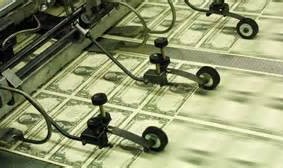Fed’s QE Ending in October: A Success or Failure?
Thursday, July 17th, 2014 @ 4:26PM
by Gary D. Halbert
Between the Lines
The Fed confirmed last week what we all had expected: it will end its massive QE bond buying program by the end of October. No surprise there. The question is, was QE a success, a failure or somewhere in between?
Some argue that without QE the economy could have plunged into a depression back in 2008-2009. Others contend that the economy would have recovered on its own, although it might have taken longer. Now we face another dilemma – the Fed is sitting on an unprecedented $4.4 trillion in long-dated Treasury bonds and mortgage-backed securities it doesn’t know what to do with.
What we do know for sure is that we are in the fifth year of a sub-par economic recovery that shows few signs of rebounding significantly anytime soon. So again, was QE a success or a failure?
Normally, when I tackle a question like this, I gather a lot of information, analyze it all carefully and then offer my conclusions. Now and then, however, I run across something that summarizes my view in one fell swoop. Such is the case with the following article that appeared in Investor’s Business Daily on Tuesday.
QUOTE:
Fed’s Failed Monetary Experiment About To End
The Fed: The [economic] recovery is not yet “complete,” Federal Reserve Chairwoman Janet Yellen suggested Tuesday, but the central bank plans to let interest rates rise anyway. We’ll soon learn just how solid this so-called recovery is.
“The economy is continuing to make progress toward the Fed’s objectives of maximum employment and price stability,” Yellen told Congress, predicting “a moderate pace” of growth for the economy “over the next several years.”
Sadly, we don’t fully share her rosy outlook. Indeed, we think the Fed’s extraordinary interventions over the past 5-1/2 years have distorted markets and prices, and have held the economy back.
Sure, by its zero-interest-rate policy (ZIRP) and $85 billion- a-month quantitative easing (QE) debt-buying program, the Fed helped push up stock prices. And low interest rates no doubt gave the economy a boost.
But now, as the Fed prepares to unwind ZIRP and QE, we’ll find out just how resilient the economy is.
A strategy of holding interest rates at zero and pumping nearly $4 trillion into financial markets may seem wise, but it’s not. It’s like putting a patient on life support for years, then expecting him to function normally.
For one, the Fed’s easy money made it easy for President Obama and Congress to spend record amounts, pushing our nation’s total indebtedness to [near] $18 trillion.
Thanks to a current Treasury bond yield of 2.5% or so, we spend “only” about $250 billion a year on interest. What happens when the Fed tightens and Treasury yields shoot up to 5%, 6% or higher?
…Taxpayers will soon learn the meaning of “no free lunch,” because taxes will have to soar to pay for Obama’s failed Keynesian spending binge — whose ill effects were disguised by Fed monetary manipulation.
Then there’s the unseen financial damage to retirees, pension funds and others who’ve seen their incomes dwindle as rates are kept artificially low. They’ve been punished for being thrifty and careful. Memo to Fed: Punishing savers is a flat-out foolish policy.
Despite this, economists and some Fed officials insist that the central bank’s quick, aggressive, post-meltdown actions saved us from another depression. In fact, the economy hasn’t responded well at all to “stimulus” by the Fed or the White House.
Since the recovery began, gross domestic product has risen a paltry 10%. By comparison, the average for all recoveries, good and bad, since World War II is 21% by this time. Doing the math, we’re missing about $1.5 trillion of annual GDP — or $4,761 in lost income for every American man, woman and child. [Emphasis mine.]
Not only is GDP smaller than it should be, but according to Heritage Foundation calculations we’re also short more than 5 million jobs. [Emphasis mine.]
Millions have left the workforce, pushing the labor participation rate down to a 36-year low of 62.8%. Our 6.1% unemployment rate is really more like 10%. [Emphasis mine.]
It’ll be years before all the damage to our economy is fully known. But it should be clear by now if it wasn’t before: The Fed’s radical intervention has not been a success, and the costs are only now becoming apparent. [Emphasis mine.]
END QUOTE
At the end of the day, the question is: Will the stock markets take a dive as QE comes to an end? I wouldn’t rule it out!
Posted by AIA Research & Editorial Staff
Categories: Between the Lines



